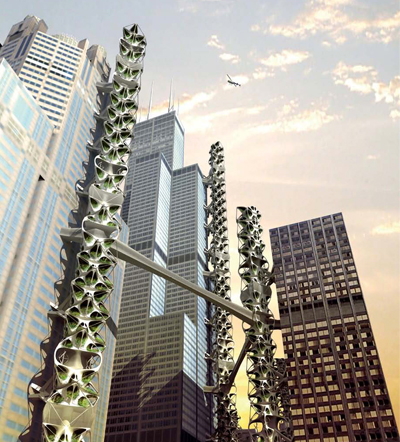
Symbiotic Interlock, Chicago. By Meta-Territory_Studio (Daekwon Park).

Earlier this summer, at a city council meeting in Cupertino, California, Steve Jobs unveiled a surprisingly static rendering for the new Apple corporate headquarters. It showed an big, glass donut-shaped building set down in a lush, edenic garden. (Perhaps some of the company’s gifted product designers can be brought on board to assist.) It was a textbook example of old-school utopian architecture, a gleaming, geometric structure sheltering a privileged, self-sustaining community. And it was strangely backward-looking, reminiscent of happy utopian visions from the 1960’s, like Buckminster Fuller’s domes, that expressed an unquestioning faith in the power of technology.
The new book “Utopia Forever,” which collects contemporary designs, both buildable and far-from-buildable, for future cities and landscapes, offers a far more ominous view. These are visions of a world where nature and technology are locked in continual battle, with nature more likely to come out on top. Now that we’re experiencing the first rattlings of global warming, troubled by extreme weather and dwindling natural resources, we’re more aware of the brute power embodied in earth, air and water. So the new utopias don’t offer blueprints for ideal communities so much as fundamental propositions for survival. Some are vessels floating above or sunk beneath rising oceans.
(more…)
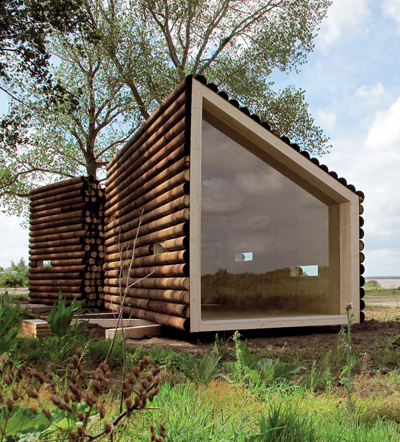
FLAKE HOUSE, 2006. By OLGGA Architectes.

Is the small house the new McMansion? With our diminishing faith in the economy and growing passion for sustainability, big, splashy houses have lost much of their luster and small, uniquely-designed homes are becoming increasingly desirable. Mimi Zeiger’s book “Micro Green: Tiny Houses in Nature” collects some innovative new designs that are small in scale but not it attitude.
Short of not building anything new at all, building at a smaller scale is the surest way to reduce a building’s environmental impact. Smaller buildings use less materials and energy, and are less disruptive to native ecologies. Small houses call on designers for expert space planning. And they call on the people living inside of it to make some significant lifestyle adjustments, like using a single space for multiple purposes, and keeping and storing fewer things. There’s simply no room for dining rooms, linen closets, and hot tubs. These homes also require a fundamental emotional shift, accepting that a small house doesn’t compromise one’s identity or quality of life. In that sense small house living has a lot in common with apartment living, something that city-dwellers are already accustomed to.
(more…)
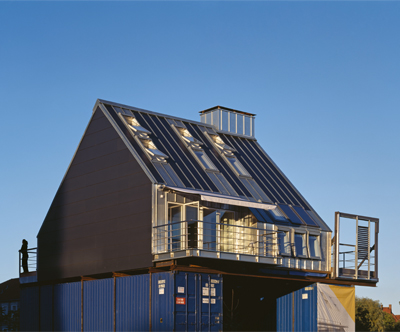
SOLTAG Exterior. SOLTAG Energy Housing, Horsholm, Denmark. Nielsen and Rubow, Cenrgia, Kuben Byfornyelse Danmark, and Velux Danmark.


There’s a mystifying number of terms used to describe green architecture and its components: renewable, sustainable, energy-saving, Energy Star, carbon-neutral, LEED-certified. Perhaps the most powerful term is zero-energy, or net-zero, which describes a building that takes no energy annually from the power grid and has no carbon emissions, so that it doesn’t burden existing systems and pollute. A new book, “Towards Zero-Energy Architecture: New Solar Design” by Mary Guzowski, takes a look at some contemporary buildings that meet this goal without sacrificing style.
Designers and builders can work to achieve zero-energy by installing appliances and heating and cooling systems that use minimal energy, and others that produce their own energy and can even contribute surplus energy back to the grid, like photovoltaic panels, geothermal wells and solar water heaters. But the most powerful strategies, and the ones more likely to shape the character of a building, are ones that incorporate so-called passive means to control light and heat, like site orientation, roof overhangs, operable windows, and shutters. Since heating, cooling and lighting are a building’s greatest energy loads, responding strategically to the sun and its movements is an important step to get to zero-energy.
(more…)

High Tech High by Jim Brady, courtesy of Studio E Architects

A weak economy was supposed to have curtailed sustainable building practices. The lack of green in developers’ wallets was expected to cause a scaling down in the greenness of their designs. Yet, while efficient building practices haven’t been immune to the recession-borne downturn of recent years in the overall construction industry, the American Institute of Architects was still able to find a variety of ambitious new structures to fill its annual list of the top ten green projects.
For the 15th year, the AIA’s Committee on the Environment has surveyed the latest work submitted by some of the country’s finest architects and agreed upon the most outstanding new creations, taking into account factors such as land use, construction materials, and the integration of energy-reducing features. Here now (listed alphabetically by project) is an overview of 2011’s environmental honor roll.
(more…)

Treehouse Lake Tegern, Community Warngau, Germany, 2004. Image courtesy of DOM Publishers.

There’s something simultaneously childlike, hippieish and fanciful about a treehouse. Who would build their home in the supple, swaying branches of a tree? And who would feel comfortable living perched so precariously off the ground? The answer is, apparently, lots of people. A new book in DOM Publisher’s “Design and Construction Manual” series, “Treehouse,” offers up serious, practical, advice, and also some inspiring contemporary examples.
Most of the treehouses featured in the book are in Central Europe, and tucked within immense, leafy perennials that look as if they’re centuries old. The book’s overarching image, of a small cottage tucked within an explosion of foliage, has a fairy-tale resonance. The trees offer protection from sun and rain, and a sweet retreat from the pressures of everyday life. Treehouse living fulfills our yearning for a simpler, more elemental way of life, one less bound up in materialism and more closely aligned with natural rhythms.
(more…)
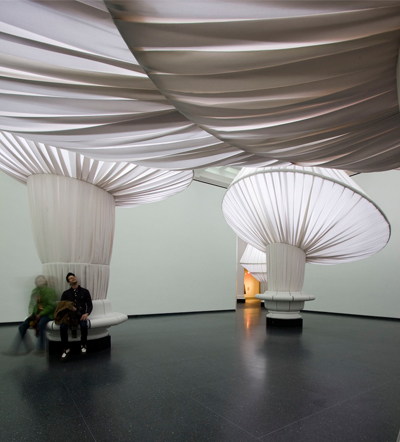
image courtesy of Situ Studio

Classical architecture carries powerful, authoritative associations, so much so that it can make even the loveliest space feel a bit stodgy and out-of-touch. So
reORDER, an installation in the Great Hall of the Brooklyn Museum by local designers
Situ Studio, is quite a feat. The installation takes the museum’s fine, neoclassical hall and gives it new life, reshaping it as a funky, informal event space.
The original museum building, designed by acclaimed nineteenth-century architects McKim Mead and White, is a stately, symmetrical mass graced with exquisite details like the Doric columns in its central hall. Through studying and manipulating the column profile Situ Studio invented sixteen new, unique profiles, and clad the existing columns with them. Each new column enclosure has a wide, solid base that can serve as a seat or as a ledge. And each one is topped with a soft, swollen, mushroom-like cap made from pleated white sailcloth draped over concealed wood hoops. The tops tip gently in different directions, obscuring the idea that columns are rational, weight-supporting elements. The overall effect is startling. The lucid geometry of the space vanishes, as does simple passage through it. The columns take over like giant, benevolent creatures. And the space, a central one that connects several galleries, becomes an engaging diversion.
(more…)
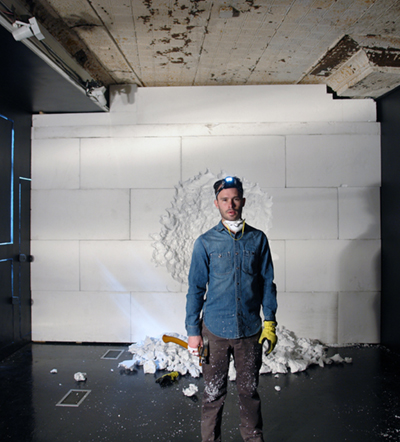

Artist Daniel Arsham and architecture collaborative Snarkitecture, comprised of Arsham and architect Alex Mustonen, whose creative practices are responsible for groundbreaking transformations in Richard Chai and Christian Dior interiors, Merce Cunningham sets, and Emmanuel Perrotin gallery spaces, now turn their attention to Storefront, March 1-April 23, for an unprecedented archaeological quarry delving deep into untapped streams of process and form. Picture a NASA mission spelunking through Hoth. The backdrop might resemble Dig.
Exploring a discourse of precision and looseness, Dig unfolds in 3 segments, the final in which Snarkitecture create and inhabit the exhibition. From March 29-April 4 Storefront will be transformed into a deep façade filled with EPS industrial foam. From April 5-23 the public will be invited to view Arsham removing pieces from solid white infill, carving tunnels, crevices, and peepholes. In this final stage, Dig will become accessible to the public through rotating doors acting as windows on the site’s exterior, and by appointment through navigable passages that Arsham has excavated. On April 23 the public will be able to enter Storefront for the closing reception at 7pm.
(more…)
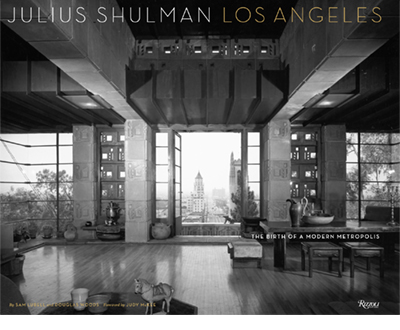
Click for Slideshow


Julius Shulman is famous for supremely elegant architectural photographs of California houses by modern masters like John Lautner, Oskar Schindler, and Charles and Rae Eames. But a new book, “Los Angeles: The Birth of a Modern Metropolis,” which showcases his personal and editorial work from the 1930’s through the 1960’s, features shots of less exalted buildings, as well as panoramas taken in and around LA. Another side of the photographer emerges, one that’s interested in the texture of the evolving city. His landscape photos are especially revealing, showing a metropolis emerging bit-by-bit as outlying farmlands and fields are given over to new school campuses, industrial complexes, and residential subdivisions.
Whatever he’s photographing– a high school gymnasium, an assembly line, or a farm– Shulman composes the frame with the same forceful diagonal sight lines he uses in his architectural photos, lines that pull a viewer right in. That he’s able to structure views of everyday buildings like gas stations, car dealerships and diners in this manner is skillful. That he’s able to structure streetscapes and landscapes this way is remarkable. His forceful perspectives give even the broadest, most diffuse views a pointed, cinematic allure, one that’s entirely fitting given the business of the city.
(more…)
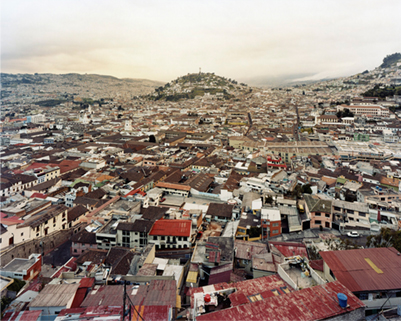
La Merced, Quito, 2010. Courtesy Yossi Milo Gallery, New York (Click for Slideshow)

Cities have a power that’s highly impressionistic. More often than not, what we remember best about the ones we’ve visited isn’t the famous monuments but the mood of particular neighborhoods and streets.Sze Tsung Leong’s series of photographs “Cities,” on display now at Yossi Milo Gallery, consists of big, bird’s-eye views of different cities around the globe. In capturing the organization, architecture and geography of each metropolis, they go a long way to convey the character of these places.
Most of Leong’s photographs don’t fall into easy postcard views. They’re elegantly composed but richly textured and shadowed so that they have an impressive tactility. And they have a greater depth and angle of vision, so that they take in broader stretches than a typical cityscape. It’s a point of view that reveals some of the historic and technological forces that have shaped each place. In Ghent the low, twisting streets around the Medieval Cathedral give way to square blocks with modern commercial buildings. And in Cairo satellite antenna sprout from the debris-strewn roofs of dusty concrete apartment buildings.
Click for Slideshow
(more…)

Click for slideshow


Just weeks ago the Danish architecture office BIG (Bjarke Ingels Group) made it very, very big, unveiling their design for a new pyramid-shaped apartment tower in midtown Manhattan. So their first monograph, “Yes is More,” comes as a happy surprise. Unlike typical starchitect monographs, packed with stiff, self-congratulatory photographs, it’s a comic book that casts Bjarke Ingels, the office’s charismatic young leader, as a superhero who flies around the world designing buildings, calling upon his tireless staff of architects back home in Copenhagen for support.
It’s a saucy, surprising self-presentation. Most architects, especially successful ones, take themselves very seriously. The book’s title is a playful — and useful — inversion of modern architect Mies van der Rohe pronouncement, “Less is more.” It’s also a bright spot of optimism in the face of a troubled global economy that has devastated the construction and architecture industries. Bjarke Ingels, superhero, challenged by limited budgets, restrictive schedules, and demanding clients, nonetheless always finds a way to get things done.
(more…)





 Facebook
Facebook Permalink
Permalink Digg
Digg Reddit
Reddit LinkedIn
LinkedIn StumbleUpon
StumbleUpon Tumblr
Tumblr













